
탄소중립 시대의 분야별 공기질 관리 기술 현황과 전망
Abstract
As the average concentration of carbon dioxide (CO2) in the earth has continuously increased over 400 ppm, climate change caused by the global warming has become a critical global issue. Air pollutants are mostly reduced in the process of reducing carbon emissions, for example, by reducing operations of coal-fired power plants and fossil-fuel vehicles. However, nitrogen oxides, ammonia and other pollutants may actually increase during the processes of switching from fossil-fuels to carbon-free fuels such as ammonia and hydrogen. Here, we take a look at what are the requirements to suppress air pollutants while reducing greenhouse gases. It is necessary to reduce directly non-exhaust fine particles from electric vehicles and also indirectly air pollutants during the process of recycling waste batteries from the electric vehicles. When a mixture of combustible wastes is used in industries as an alternative instead of bituminous coal, it is also needed to reduce air pollution emissions during its incineration. It becomes more important to develop a strategy for energy optimization by internet of things (IoT) monitoring and artificial intelligence (AI) prediction in the industrial sites and residential buildings. In addition, we have to investigate steadily the atmospheric aerosol itself from a climate change point of view. And it is also necessary to conduct a lot of field studies for removal of non-CO2 greenhouse gases and short-lived climate pollutants (SLCP).
Keywords:
Global warming, Carbon neutral scenario, Atmospheric pollutants, Carbon-free fuels, Energy-efficiency, Net zero, Climate change1. 서 론
지구의 이산화탄소 (carbon dioxide, CO2) 농도는 그림 1과 같이 빙하기와 간빙기를 거치면서 180 ppm과 280 ppm 사이를 주기적으로 반복하였다. 하지만 산업혁명 이후로 급격히 증가하여 2015년 이후로 400 ppm을 초과하였고 최근에는 10년간 해마다 약 2.5 ppm씩 증가하고 있는 것으로 보고되고 있다 (Novoselova and Omel’chuk, 2023; Lüthi et al., 2008). 이러한 전 세계적인 CO2 농도 증가는 기후변화의 위기를 초래하고 있어 탄소배출을 줄이기 위한 전 지구적인 노력이 요구되고 있다. 탄소중립을 실현하기 위한 노력으로 2022년 기준 탄소중립을 선언한 나라는 147개국이고, Renewable Energy 100 (RE100) 가입 기업도 국내 27개사를 포함하여 334개사에 이르고 있다 (RE100, 2023). 대한민국 또한 2020년 10월에 2050 탄소중립 추진계획을 발표하고 2030년까지 CO2 농도를 2018년 대비 35% 저감 목표를 설정하였다 (Phillips, 2022). 도시형 태양광 및 해상풍력 발전, 전기차 및 수소차 전환, 바이오 석유화학과 바이오연료 활용 등 탄소중립을 위한 2050 미래상이 예상되고 있다. 하지만 탄소중립 기술만으로 환경 측면에서 삶이 안정될 수 있을지 대기 환경 관점에서 살펴볼 필요가 있다. 태양광, 풍력 등의 발전 수단의 전환을 통해 탄소중립 실현 과정에서 대기오염물질을 크게 줄일 수 있을 것으로 기대되고 있다. 하지만 무탄소 연료로의 전환 (Sun et al., 2021; Li et al., 2014), 폐배터리 처리 (Ashok et al., 2021; Gottesfeld and Pokhrel, 2011) 등 탄소중립 과정에서 오히려 대기오염물질을 증가시키는 경우도 발생할 수 있다. 따라서 온실가스를 줄이면서도 대기오염물질을 같이 고려하여 줄이기 위한 노력이 매우 필요하다고 볼 수 있다.
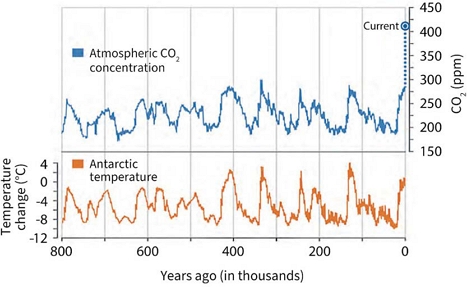
Data from ice cores have been used to reconstruct Antarctic temperatures and atmospheric CO2 concentrations over the past 800,000 years (Lüthi et al., 2008).
2050 탄소중립 시나리오를 살펴보면 전환 부문에서 무탄소 가스터빈의 활용 (Banihabib and Assadi, 2022)이 확대될 것으로 기대된다. 산업 부문에서는 연료전환과 공정가스 전환 (Schneider, 2019; Jahansson, 2013)이 주요 수단으로 예상되고 있다. 건물 부문에서는 건물 에너지 효율 향상 (Min et al., 2022), 수송 부문에서는 교통수단 전기 및 수소화 (Dulău, 2023), 농축수산 부문에서는 바이오 매스 활용 (Weiland, 2006) 등이 기대되고 있다. 하지만 앞에서 언급한 주요 달성 수단들은 기존보다 대기오염물질을 더욱 배출할 수 있는 가능성이 상당히 있는 방법임을 인식할 필요가 있다.
본 논문에서는 분야별 2050 탄소중립 시나리오의 주요 달성 수단 중 탄소중립의 실현 과정에서 대기오염을 오히려 증가시키는 우려가 있는 부분을 살펴보고자 한다. 이와 함께 온실가스와 대기오염을 동시에 줄이기 위해서는 어떠한 요구 사항이 있을 수 있는지 파악해 보고자 한다. 또한 탄소중립과 관련된 대기환경 이슈 이외에도 향후 대기오염을 줄이기 위한 앞으로의 새로운 연구 분야에 대해서도 전망해 보고자 한다.
2. 탄소중립 과정의 대기오염 이슈
2. 1 전환 분야
발전 부문에서는 수소 (Hydrogen, H2)나 암모니아 (Ammonia, NH3)와 같은 무탄소 연료를 이용하여 발전하는 노력을 기울이고 있다. 석탄에 NH3를 혼합하여 연소시킴으로써 석탄 화력 발전 대비 CO2 발생량을 줄이기 위한 방안을 마련하고 있고 (Lee and Lee, 2021), 천연가스와 NH3를 혼소시키는 NH3 가스터빈 (Kurata et al., 2019)이나 H2를 연소시키는 H2 가스터빈 (Pashchenko, 2023)이 복합 화력발전의 수단으로 고려되고 있다. 하지만 석탄이나 천연가스에 NH3를 혼소 연소시킬 경우 NH3 연료 안에 포함되어 있는 질소로 인해 아래 식 (1), (2)와 같이 연료 기인 질소산화물 (Nitrogen oxides, NOx) 발생량이 크게 증가할 수 있다 (Elbaz et al., 2022). 또한 식 (3)과 같이 지구 온난화 지수가 CO2 대비 약 300배가량 높은 아산화질소 (Nitrous oxide, N2O)도 수십에서 수백 ppm 수준으로 발생할 수 있다 (Zhu et al., 2021).
| (1) |
| (2) |
| (3) |
특히 N2O의 경우 만약 200 ppm이 발생한다면 온난화지수로 환산된 CO2 배출량이 6% 정도가 되어 천연가스 연소에 의한 CO2 발생량 4% 대비 약 1.5배 높은 온실가스를 배출할 수 있다 (Kurata et al., 2017). 또한 NH3가 미연소 상태로 배출될 경우 NH3로 인해 열교환기나 배관이 부식될 수 있고 (Chiong et al., 2021; Gong et al., 2018) 대기로 배출될 경우 미세먼지 전구물질로 작용하여 대기환경에 직접적인 영향을 줄 수도 있다 (Miller et al., 2002). H2 연료를 사용할 경우에도 고온 반응에 의해 NOx가 증가할 수 있어 NOx를 줄이기 위한 희박 연소와 같은 연소 조건의 개선이 요구되고 있다 (Kikuchi et al., 2022).
2. 2 수송 분야
수송 부문에서는 기존 가솔린이나 디젤 자동차에서 전기차로의 전환이 활발하게 이루어지고 있다. 하지만 최근 자동차의 배출 오염물질과 관련하여 배기계의 오염물질뿐만 아니라 브레이크, 타이어, 도로 마모 먼지 등에 해당하는 비배기계 미세먼지에 대한 관심이 증가하고 있다 (Timmers and Achten, 2016). 그림 2와 같이 일부 연구에서는 도로 재비산 먼지 (Re-suspended road dust), 도로 마모 먼지 (Road wear particle, RWP), 타이어 마모 먼지 (Tire wear particle, TWP), 브레이크 마모 먼지 (Brake wear particle, BWP) 등의 자동차의 비배기계 미세먼지 발생량이 배기계 미세먼지 발생량 (Primary exhaust)보다 훨씬 높은 비중을 차지하고 있다. 또한 전기차 (Electric vehicle, EV)로 전환될 경우 배터리에 의한 무게 증가로 인해 기존 가솔린이나 디젤 차량에 비해 타이어나 도로 마모 미세먼지는 더욱 증가할 수도 있다 (Woo et al., 2022; Beddows and Harrison, 2021; Mrozik et al., 2021; Simons, 2016; Timmers and Achten, 2016; Amato et al., 2014). 따라서 1차 미세먼지 관점에서는 비배기계 미세먼지 저감 없이는 전기차로 전환이 미세먼지를 크게 줄이지 못할 수도 있다.
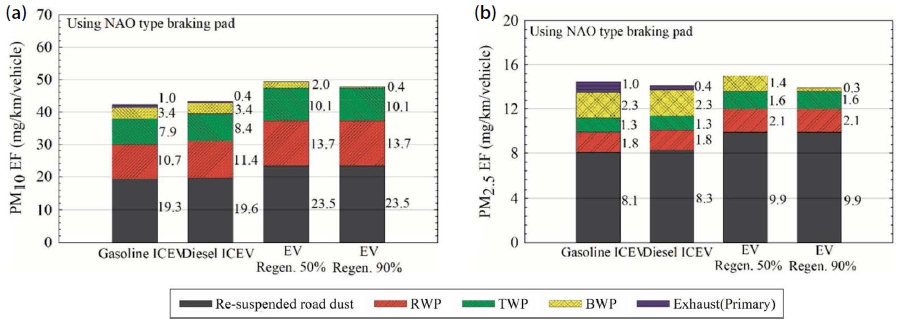
The emission factors of total PM from primary exhaust and non-exhaust sources, according to vehicle types. Here, RWP is road wear particle, TWP is tire wear particle and BWP is brake wear particle (Woo et al., 2022).
선박의 경우 전기 수송선에 대한 연구도 활발하나 NH3 연료 선박으로의 전환도 고려되고 있다. 그림 3과 같이 NH3 (100% NH3)나 H2 (100% H2) 연료 엔진의 경우 앞의 발전 분야와 마찬가지로 기존 디젤 연료 엔진 (0%) 대비 NOx 증가, N2O에 의한 온실가스 배출 효과, 미연소 NH3 슬립 (slip)에 의한 대기오염 증가 등의 문제가 존재하므로 이를 해결하기 위한 방안 마련이 필요하다 (Lyu et al., 2023; Gill et al., 2012).
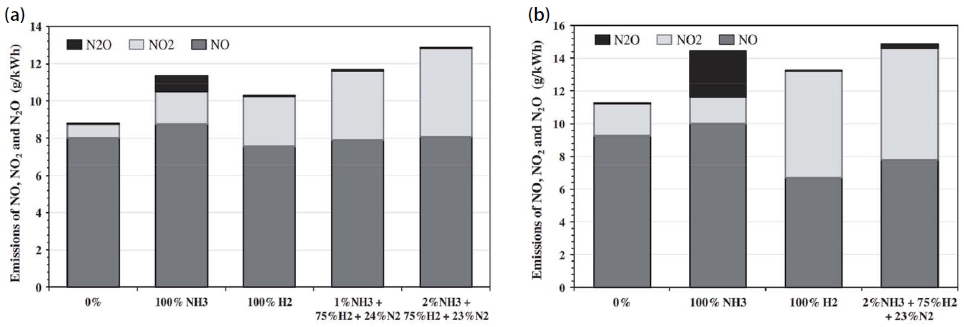
N2O, NO2, and NO emissions under 5 bar (a) and 3 bar (b) indicated mean effective pressure engine loads (Gill et al., 2012).
수송 분야에서 전기차나 전기 선박으로 전환될 경우 폐배터리의 발생량이 크게 증가할 것으로 예상된다. 따라서 앞으로 폐배터리로부터 코발트, 니켈과 같은 유가 금속을 회수하는 산업이 크게 증가할 것으로 기대된다. 폐배터리에서 금속을 회수하는 공정으로 건식공정과 습식공정으로 구분할 수 있다. 건식공정에서는 분쇄나 용융 과정에서 입자상물질 (particulate matter, PM), NOx 등의 대기오염물질이 발생할 수 있고, 추출 과정에서 폐수가 발생할 수 있다. 습식공정에서는 열처리 과정에서 PM, NOx 등의 대기오염물질이 발생할 수 있고 침출, 여과 및 추출 과정에서 폐수가 발생할 수 있다 (Kumar et al., 2022; Mrozik et al., 2021).
2. 3 산업 분야
산업 분야에서는 화석연료의 연소 가열 부분을 전기로 전환시키거나 화석연료 대신 폐플라스틱, 폐타이어 등의 순환자원을 활용하는 방법이 활발하게 진행되고 있다 (Kim et al., 2012). 특히 시멘트 산업에서는 시멘트 소성로에 유연탄을 사용해왔는데 이를 가연성 폐기물로 전환하여 온실가스 발생을 크게 줄이고 있다. 또한 2030년까지 유연탄 사용량을 제로화하기 위해 이를 지속적으로 확대하고 있다 (Choi et al., 2010). 하지만 가연성 폐기물의 수요가 증가하면서 충분히 재사용이 가능한 폐기물도 분류 없이 소각이 되는 경우가 많아지고 있다. 특히 미국, 독일, 프랑스 등의 선진국과 비교해 볼 때 국내에서는 보조연료나 부연료로 사용되는 폐기물의 종류가 매우 많다. 무분별한 폐기물의 혼합 연소로 인해 다이옥신 (Yoneda et al., 2002), 다환 방향족 탄화수소 (Polycyclic Aromatic Hydrocarbons, PAHs) (Vejerano et al., 2013) 등 다양한 환경 오염물질이 배출될 수 있다. 그리고 산업 공정에서의 폐기물 소각 활용 과정에서 배출 규제가 일반 소각장에서의 배출 규제 대비 느슨한 면이 있어서 대기오염물질 배출량이 오히려 증가할 수도 있다.
산업 분야의 온실가스 저감 방안으로 에너지 소비량을 줄이는 방안도 고려되고 있다. 산업부에서는 2019년 에너지효율 혁신전략을 통해 2030년 최종에너지 소비를 배출전망치 (BAU) 대비 14.4%, 2017년 대비 27.4% 절약하기 위한 고효율 에너지 소비구조 목표를 제시하였다. 이는 정책 수단을 개선하여 줄일 수도 있지만 산업 활동에서 효율 혁신을 통한 에너지 절약이 매우 중요하다. 대기오염 방지시설에서의 에너지 절약도 산업 분야 에너지 절약의 한 부분이 될 수 있다. 왜냐하면 국내 사업장 약 5만여 개에는 약 55만 개의 배출시설을 갖고 있고, 방지시설이 약 16만 8천여 개나 존재하고 있기 때문이다. 따라서, 산업 생산 공정에서의 효율 혁신뿐만 아니라 대기환경 관리 관점에서 16만 개 이상되는 환경설비 운영에 대한 효율 개선도 매우 중요하다고 할 수 있다.
2. 4 건물 분야
건물에서의 에너지 소비량은 전체의 20% 이상을 차지하고 있다 (Pérez-Lombard et al., 2008). 따라서 건물에서는 주로 건물 에너지 효율 향상을 통해 CO2 배출을 줄이고자 노력하고 있다. 하지만 건물 에너지를 줄이기 위한 건물 단열 및 기밀 강화는 환기량 부족에 따라 실내 공기질을 악화시킬 수 있다. 최근 건물 에너지 절약이 강화되면서 환기량이 감소되고 있고 미세먼지, 휘발성유기화합물 (Volatile organic compounds, VOCs), 폼알데하이드, 부유 세균, 라돈 등의 실내 오염물질 농도가 증가하고 있다 (Kempton et al., 2022). 실내 공기질 향상을 위해서는 환기할 때 냉난방 손실과 함께 환기장치, 공기청정기 운전과 같은 에너지 소비가 필연적으로 이루어질 수밖에 없다. 건물 에너지와 실내 공기질은 서로 역비례 관계에 있어서 건물 에너지를 줄이면서 실내 공기질을 향상시키는 것은 어려운 숙제이다. 따라서 건물 분야에서 에너지 효율 향상 과정에서 악화될 수 있는 실내 공기질 개선을 위해서는 건물 에너지와 실내환경을 연계한 최적화된 관리 기술 마련이 필요하다.
3. 탄소중립 실현 과정에서의 대기오염 해결 요구 기술
3. 1 전환 분야
전환 부문에서 무탄소 연료 사용 확대에 따른 NOx, N2O 및 NH3 배출 증가 문제를 해결할 필요가 있다. 무탄소 연료 연소 과정에서의 NOx 배출 저감을 위한 연소 기술 개발이 무엇보다 필요하다. 또한 고농도 저온 조건에서의 NOx 처리 기술과 N2O까지 동시 처리하기 위한 촉매 기술 개발도 요구된다. NH3 슬립 억제를 위한 공정 최적화와 함께 배출 감시 모니터링 기술도 필요하다. 일본에서는 IHI사 등에서 NH3와 미분탄 연료의 혼소 발전 시스템에서 NOx 발생 저감을 위한 연소 기술, 보일러 내부 유동 해석 및 기술에 대한 연구 개발을 활발하게 진행 중에 있다 (Ito et al., 2020). 국내의 경우도 NH3나 H2를 연료로 활용하는 가스터빈 및 가스엔진 연구가 활발하게 진행되고 있다 (Shin and Park, 2023; Moon et al., 2022; Lee et al., 2021; Oh et al., 2021; Lee and Song, 2018).
3. 2 수송 분야
수송 분야에서는 비배기계 미세먼지를 줄이기 위한 노력이 매우 필요하다. 영국의 The Tyre Collective사, 프랑스의 Tallano사 등과 같이 유럽 국가들을 중심으로 자동차 비배기 미세먼지 저감장치 분야로 스타트업 기업들이 나타나기 시작하였다. 독일의 주요 필터 업체인 Mann+Hummel사에서도 브레이크 발생 미세먼지를 포집하기 위한 저감장치 개발을 선도적으로 진행하고 있다 (Wang et al., 2022). 한국기계연구원에서는 브레이크 마모에 의해 생성되는 미세먼지를 포집할 수 있는 원리를 파악하기 위해 브레이크 기인 미세먼지의 전기적 및 자기적 특성에 대한 연구를 보고하였다 (Jo et al., 2023). 앞 절에서 언급한 것과 같이 폐배터리로부터 유가 금속을 회수하기 위한 습식 및 건식 공정 관련 연구도 활발하게 진행되고 있다. 다만 이러한 폐배터리 리사이클링 과정에서 배출되는 대기 및 수질오염물질 처리에 대한 연구는 매우 미흡한 실정이다. 따라서 폐배터리 재활용 공정의 친환경 대기 및 수질오염 처리 기술 개발이 요구되고 있다.
3. 3 산업 분야
산업 분야에서는 가연성 폐기물에서 재사용 가능한 폐기물을 최대한 분류 선별하도록 해야 한다. 재사용이 어려운 폐기물에 대해서만 소각시켜 그 열에너지를 활용하도록 하고, 대기 및 수질 환경오염물질 배출을 최대한 줄이기 위한 처리 기술의 성능 고도화도 필요하다. 또한 산업 분야에 활용하는 폐기물에 대해서도 일반 소각시설과 동일한 배출 기준으로 관리가 되어야 할 것이다. 최근 고형 폐기물 연료 (Solid refuse fuel, SRF)의 확대 노력에도 지역 주민들의 반대로 사업 추진에 어려움을 겪고 있다. 따라서 처리 기술에 대한 성능 고도화와 함께 더욱 더 안전한 오염물질 배출 관리 방안 마련이 필요하다고 할 수 있다. 그림 4와 같이 스웨덴 Gothenburg 대학에서는 스크러버 발생 폐수를 보일러로 재순환시키는 방법을 적용하여 NOx 발생을 줄이면서 폐수 발생량도 최소화시키는 연구를 진행하고 있다 (Gall et al., 2022).
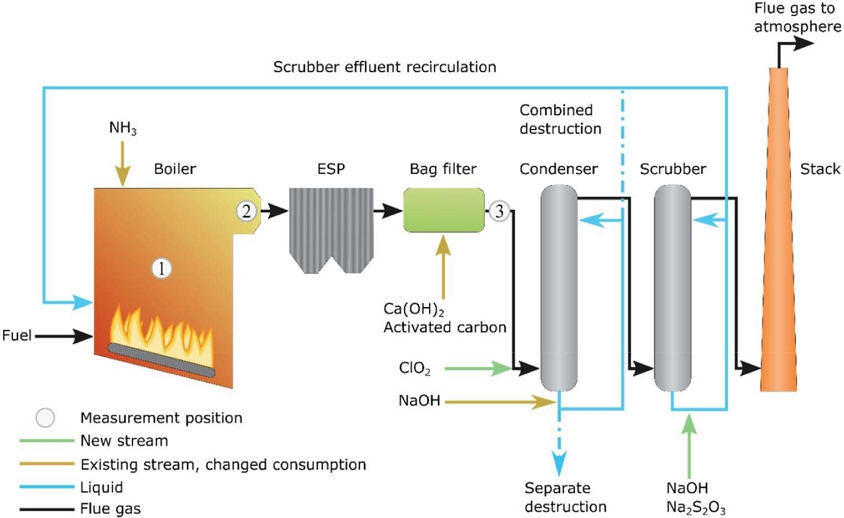
Schematic of the 2.5 MWth waste-to-energy plant, including the recirculation streams from the scrubber and condenser (from Gall et al., 2022).
산업 분야의 환경설비에 대해 에너지효율 향상과 함께 오염물질의 저감 성능 향상을 위해서는 환경설비의 공정 최적화가 매우 필요하다. 이를 위해서는 산업 공정 및 환경설비에서의 주요 환경변수에 대한 데이터를 충분히 수집하고 이를 활용하여 공정을 최적화시키는 기술 개발이 필요하다 (Hoang et al., 2022). 일본의 Yokogawa사에서는 소각 플랜트에서 실시간 산소농도를 측정하여 소각 성능 향상과 함께 NOx와 CO 배출량을 줄이고 있다 (Yokogawa, 2016). Horiba사에서는 소각 플랜트 공정 전 과정에 적용 가능한 다양한 센서들을 개발하여 소각 플랜트 공정의 최적화를 추진하고 있다 (Oshita et al., 2016). 국내의 SK에코플랜트에서는 소각로에 아마존 웹서비스의 인공지능 솔루션을 적용하여 다양한 운전 데이터로부터 NOx, CO 등의 오염물질 배출량을 줄이는 연구를 진행하고 있다. 환경부에서는 4·5종 사업장 방지시설에 대해 전류, 차압, pH, 온도 등을 실시간으로 측정하는 사물인터넷 시스템을 의무적으로 도입하는 제도를 시행하기로 하였다. 따라서 측정되는 실시간 정보는 사업장의 방지시설의 가동 여부를 파악하는 것 이외에도 방지시설의 효율적 운전 제어를 위한 중요한 데이터로도 활용될 수 있기를 기대하고 있다. 또한 앞으로는 다수의 고가 센서를 이용하여 오염물질 배출량을 직접 측정하고 측정 데이터에 기반하여 제어 운전을 수행하는 기존의 방식으로부터 소수의 저가 센서를 이용하여 운전 데이터를 확보하고 인공지능을 이용하여 배출량을 추정한 뒤 예측 배출량을 기반으로 운전 환경을 제어하는 방식으로의 전환이 필요하다.
3. 4 건물 분야
건물 분야에서 에너지 효율 향상과 함께 실내공기질 개선을 위해서는 건물 에너지와 실내환경을 동시에 고려한 관리 최적화가 요구되고 있다 (Valladares et al., 2019). 프랑스의 Veolia사에서는 건물 내 곳곳에 스마트 실내공기질 센서들을 설치하여 실시간으로 공기질 상태를 분석하고 공기정화 시스템의 운전 상태에 대한 정보를 동시에 수집하여 이를 공기질 제어 및 유지관리에 연동하고 있다. 또한, 건물 재실자에게는 공기질에 대한 정보 제공과 함께 공기질과 에너지 성능에 대한 성능 보증을 하고 있다. 국내의 경우 한국건설기술연구원에서 2019년부터 2022년까지 실내공기품질융합연구단을 통해 다중이용시설에서 실내공기질 상태와 유동인구에 대한 정보를 수집하고 이용자의 체감을 고려하여 실내공기질을 개선시키면서 안전사고에 신속 대응하는 연구를 진행하였다 (Kim et al., 2021). 단국대학교에서는 실시간으로 에너지와 실내 건강환경을 관리하는 인공지능 기반의 자율운전 시스템을 개발하는 연구를 활발히 진행 중에 있다 (Yoon et al., 2022).
4. 기타 기후변화 대응 대기오염 관리 연구
지금까지 탄소중립 실현 과정에서 대기오염을 유발시킬 수 있는 여러 분야에 대해 살펴보았다. 하지만 탄소중립 시나리오와는 직접적인 관련이 없지만 기후변화에 대응하여 지속적으로 대기오염 관리가 필요한 연구 분야를 살펴볼 필요가 있다. 먼저 대기 에어로졸은 기상 활동에 매우 중요한 변수로 작용하고 있고 복사 강제력의 불확실성 또한 매우 높으므로 에어로졸 자체를 기후변화의 주요 인자로서 접근하고 연구를 지속적으로 수행할 필요가 있다 (Ren-Jian et al., 2012; Andreae et al., 2005; Huebert et al., 2003; Lohmann and Lesins, 2002). 또한 반도체, 디스플레이, 축산, 매립지 등에서 배출되는 불소화합물, 메탄, N2O 등의 비이산화탄소 온실가스 저감에 대한 노력이 더욱 더 필요하다. 1990년부터 2019년까지 발생된 온실가스의 약 25%는 비이산화탄소 온실가스가 차지하고 있기 때문이다 (Olivier and Peters, 2020). 환경부에서는 Non-CO2 온실가스 저감 기술 개발 사업단을 2013년부터 2020년까지 운영하여 반도체 생산공정의 불화가스 처리 기술 개발, 폐냉매의 정제 재생 기술 개발 등 많은 성과를 이루었다. 하지만 추가적으로 반도체, 디스플레이 분야에서 온실가스와 대기오염물질을 동시에 저감시키는 기술 개발이나 축산시설 및 매립지에서의 메탄 저감에 대한 실증 연구가 더욱 지원 될 필요가 있다. 한편, 블랙카본 (Black carbon, BC)과 오존 (Ozone, O3), 수소불화탄소 (Hydrofluorocarbons, HFCs)와 같은 단기체류 기후변화 유발물질 (short-lived climate pollutants, SLCP)에 대한 저감 노력도 필요하다. 그림 5와 같이 단기체류 기후변화 유발물질은 감축할 때 약 0.6°C 정도의 즉각적인 지구 온도 증가 억제 효과를 기대할 수 있기 때문이다 (Xu and Ramanathan, 2017). 지금까지 설명한 탄소중립 과정의 대기오염 이슈와 이에 대한 대응 요구 기술에 대해 정리하면 다음의 표 1과 같다.
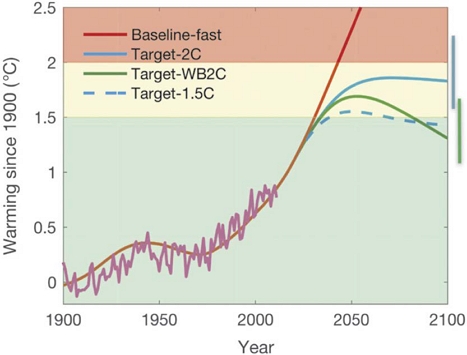
Model-simulated temperatures for the 20th century and their projections into the 21st century under four different scenarios (Xu and Ramanathan, 2017).
5. 결 론
2050 탄소중립 시나리오의 감축수단을 수행함에 있어서 탄소중립 실행 과정에서 대기오염물질이 감소하는 경우가 많으나 상황에 따라 대기오염물질이 오히려 증가할 수 있다. 전환 분야에서는 무탄소 연료로의 전환 과정에서 NOx, N2O 및 미반응 NH3에 대한 저감 노력이 필요하다. 수송 분야에서는 전기차로의 전환 과정에서 비배기계 미세먼지 관리나 폐배터리의 재활용 때 발생하는 대기, 수질오염 관리도 필요할 것으로 보인다. 산업 분야에서는 유연탄 대신 가연성 폐기물을 활용하는 과정에서 대기오염물질 배출을 줄이기 위한 추가적인 노력이 필요하다. 산업 분야의 환경설비 최적 운전이나 건물 분야의 에너지-실내환경 관리를 위해서는 IoT 센서, 모니터링 정보 수집 및 인공지능 예측 등을 통한 저감 기술의 지능화 및 고도화가 필요하다. 이 외에도 복사 강제력 관점에서의 기후 에어로졸 연구와 함께 비이산화탄소 온실가스와 단기체류 기후변화 유발물질 관련 대응 기술의 고도화 및 실증 연구 등이 지속적으로 수행되어야 할 것이다.
탄소중립 실현 과정에서 분야별로 적절한 공기질 관리 기술이 동반되어야만 2050 탄소중립 미래상에서 청정한 대기 환경을 그려낼 수가 있을 것이다. 이를 위해서는 온실가스과 대기오염물질을 동시에 고려한 기술적 접근을 통해 탄소중립 실현과 대기오염 저감의 시너지효과를 극대화시킬 수 있는 기술 개발이 필요하다. 또한 정부에서는 탄소 대기환경 융복합 기술에 대한 적극적인 R&D 투자와 함께 새로운 미래 기술 개발과 관련된 선제적인 정책 마련도 필요하다.
Acknowledgments
본 연구는 2023년 해양수산부 재원으로 해양수산과학기술진흥원의 지원을 받아 수행된 연구임 (20220568, 중소선박 보급형 온실가스 등 저감장치 개발).
References
-
Amato, F., Cassee, F.R., Denier van der Gon, H.A.C., Gehrig, R., Gustafsson, M., Hafner, W., Harrison, R.M., Jozwicka, M., Kelly, F.J., Moreno, T., Prevot, A.S.H., Schaap, M., Sunyer, J., Querol, X. (2014) Urban Air Quality: The Challenge of Traffic Non-Exhaust Emissions, Journal of Hazardous Materials, 275, 31-36.
[https://doi.org/10.1016/j.hazmat.2014.04.053]

-
Andreae, M.O., Jones, C.D., Cox, P.M. (2005) Strong Pre-sent-day Aerosol Cooling Implies a Hot Future, Nature, 435, 1187-119.
[https://doi.org/10.1038/nature03671]

-
Ashok, K., Babu, M., Jula, V., Mullai, N.K. (2021) Impact of Used Battery Disposal in the Environment, Linguistics and Culture Review, 5(S1), 1276-1286.
[https://doi.org/10.37028/lingcure.v5nS1.1598]

-
Banihabib, R., Assadi, M. (2022) A Hydrogen-Fueled Micro Gas Turbine Unit for Carbon-Free Heat and Power Generation, Sustainability, 14(20), 13305.
[https://doi.org/10.3390/su142013305]

-
Beddows, D.C.S., Harrison, R.M. (2021) PM10 and PM2.5 Emission Factors for Non-Exhaust Particles from Road Vehicles: Dependence upon Vehicle Mass and Implications for Battery Electric Vehicles, Atmospheric Environment, 244, 117886.
[https://doi.org/10.1016/j.atmosenv.2020.117886]

-
Chiong, M.C., Chong, C.T., Ng, J.H., Mashruk, S., Chong, W.W.F., Samiran, N.A., Mong, G.R., Valera-Medina, A. (2021) Advancements of Combustion Technologies in the Ammonia-Fuelled Engines, Energy Conversion and Management, 244, 114460.
[https://doi.org/10.1016/j.enconman.2021.114460]

- Choi, W.-Z., Park, E.-K. Park, K.-H. (2010) Environmental Impact Analysis on Cement Manufacturing Process with Waste Utilization, Magazine of the Korea Concrete Institute, 22(3), 36-40, (in Korean with English abstract).
-
Dulău, L.I. (2023) CO2 Emissions of Battery Electric Vehicles and Hydrogen Fuel Cell Vehicles, Clean Technologies, 5(2), 696-712.
[https://doi.org/10.3390/cleantechnol5020035]

-
Elbaz, A.M., Wang, S., Guiberti, T.F., Roberts, W.L. (2022) Review on the Recent Advances on Ammonia Combustion from the Fundamentals to the Applications, Fuel Communications, 10, 100053.
[https://doi.org/10.1016/j.jfueco.2022.100053]

-
Gall, D., Allguren, T., Jahansson, J., Normann, F., Hultén, A.H., Gunnarsson, A., Andersson, K. (2022) Recirculation of NOx and SOx Scrubber Effluent to an Industrial Grate Fired MSW Boiler - Influence on Combustion Performance, Deposition Behavior, and Flue Gas Composition, Energy Fuels, 36(11), 5868-5877.
[https://doi.org/10.1021/acs.energyfuels.2c00293]

-
Gill, S.S., Chatha, G.S., Tsolakis, A., Golunski, S.E., York, A.P.E. (2012) Assessing the Effects of Partially Decarbonising a Diesel Engine by Co-Fuelling with Dissociated Ammonia, International Journal of Hydrogen Energy, 37, 6074-6083.
[https://doi.org/10.1016/j.ijhydene.2011.12.137]

-
Gong, B.J., Park, J., Kim, J.-H., Kim, Y.-H., Kim, H.-J., Kim, H.-C., Lee, S.B., Kim, D.G., Kim, J.S., Choi, G.H. (2018) A Study on Boiler Corrosion and Dust Emission Characteristics of Natural Gas Turbine Power Plants, Journal of the Korean Society of Urban Environment, 18(1), 117-126, (in Korean with English abstract).
[https://doi.org/10.33768/ksue.2018.18.1.117]

-
Gottesfeld, P., Pokhrel, A.K. (2011) Review: Lead Exposure in Battery Manufacturing and Recycling in Developing Countries and Among Children in Nearby Communities, Journal of Occupational and Environmental Hygiene, 8(9), 520-532.
[https://doi.org/10.1080/15459624.2011.601710]

-
Hoang, T.-D., Ky, N.M., Thuong, N.T.N., Nhan, H.Q., Ngan, N.V.C. (2022) Artificial Intelligence in Pollution Control and Management: Status and Future Prospects. In: Ong, H.L., Doong, R., Naguib, R., Lim, C.P., Nagar, A.K. (eds) Artificial Intelligence and Environmental Sustainability. Algorithms for Intelligent Systems. Springer, Singapore.
[https://doi.org/10.1007/978-981-19-1434-8_2]

-
Huebert, B.J., Bates, T., Russell, P.B., Shi, G., Kim, Y.J., Kawamura, K., Carmichael, G., Makajima, T. (2003) An Overview of ACE-Asia: Strategies for Quantifying the Relationships between Asian Aerosols and their Climatic Impacts, Journal of Geophysical Research, 108(D23), 8633.
[https://doi.org/10.1029/2003JD003]

- Ito, S., Uchida, M., Suda, T., Fujimori, T. (2020) Development of Ammonia Gas Turbine Co-Generation Technology, IHI Engineering Review, 53(1), 1-6. https://www.ihi.co.jp/en/technology/sdgs/topic01/pdf/Vol53No1_H.pdf
-
Jo, C., Shin, D., Lee, G., Woo, S.-H., Lee, S., Han, B., Hwang, J. (2023) Analysis of Charge and Magnetic Characteristics of Brake Wear Particles, Particle and Aerosol Research, 19(2), 31-42, (in Korean with English abstract).
[https://doi.org/10.11629/jpaar.2023.19.2.011]

-
Johansson, M.T. (2013) Bio-Synthetic Natural Gas as Fuel in Steel Industry Reheating Furnaces - A Case Study of Economic Performance and Effects on Global CO2 Emissions, Energy, 57, 699-708.
[https://doi.org/10.1016/j.energy.2013.06.010]

-
Kempton, L., Daly, D., Kokogiannakis, G., Dewsbury, M. (2022) A Rapid Review of the Impact of Increasing Airtightness on Indoor Air Quality, Journal of Building Engineering, 57, 104798.
[https://doi.org/10.1016/j.jobe.2022.104798]

-
Kikuchi, K., Motegi, T., Hori, T., Akamatsu, F. (2022) Influence of Nozzle Design Parameters on Exhaust Gas Characteristics in Practical-Scale Flameless Hydrogen Combustion, International Journal of Hydrogen Energy, 47(49), 21287-21297.
[https://doi.org/10.1016/j.ijhydene.2022.04.230]

-
Kim, C., Choi, D., Lee, Y.G., Kim, K. (2021) Diagnosis of Indoor Air Contaminants in a Daycare Center using a Long-term Monitoring, Building and Environment, 204, 108124.
[https://doi.org/10.1016/j.buildenv.2021.108124]

- Kim, Y.W., Kim, J.B., Hwang, Y.W., Park, J.H. (2012) Economic Analysis and CO2 Emissions Analysis by Circulating the Industrial Waste Resource between Companies, Clean Technology, 18(1), 111-119, (in Korean with English abstract).
-
Kumar, S., Rahman, M.A., Islam, M.R., Hashem, M.A., Rahman, M.M. (2022) Lead and Other Elements-Based Pollution in Soil, Crops and Water near a Lead-Acid Battery Recycling Factory in Bangladesh, Chemosphere, 290, 133288.
[https://doi.org/10.1016/j.chemosphere.2021.133288]

-
Kurata, O., Iki, N., Inoue, T., Matsunuma, T., Tsujimura, T., Furatani, H., Kawano, M., Arai, K., Okafor, E.C., Hayakawa, A., Kobayashi, H. (2019) Development of a Wide Range-Operable, Rich-Lean Low-NOx Combustor for NH3 Fuel Gas-Turbine Power Generation, Proceedings of the Combustion Institute, 37(4), 4587-4595.
[https://doi.org/10.1016/j.proci.2018.09.012]

- Kurata, O., Iki, N., Inoue, T., Matsunuma, T., Tsujimura, T., Furutani, H., Kobayashi, H., Hayakawa, A. (2017) Combustion Emissions from NH3 Fuel Gas Turbine Power Generation Demonstrated, 2017 AlChE Annual Meeting, Minneapolis, MN, USA. www.ammoniaenergy.org/wp-content/uploads/2019/12/NH3-Energy-2017-Osamu-Kurata.pdf
-
Lee, D., Song, H.H. (2018) Development of Combustion Strategy for the Internal Combustion Engine Fueled by Ammonia and Its Operating Characteristics, Journal of Mechanical Science and Technology, 32(4), 1905-1925.
[https://doi.org/10.1007/s12206-018-0347-x]

-
Lee, H., Lee, M.-J. (2021) Recent Advances in Ammonia Combustion Technology in Thermal Power Generation System for Carbon Emission Reduction, Energies, 14(18), 5604.
[https://doi.org/10.3390/en14185604]

-
Lee, S., Kim, G., Bae, C. (2021) Lean Combustion of Stratified Hydrogen in a Constant Volume Chamber, Fuel, 301, 121045.
[https://doi.org/10.1016/j.fuel.2021.121045]

-
Li, J., Huang, H., Kobayashi, N., He, Z., Nagai, Y. (2014) Study on Using Hydrogen and Ammonia as Fuels: Combustion Characteristics and NOx Formation, International Journal of Energy Research, 38(9), 1214-1223.
[https://doi.org/10.1002/er.3141]

-
Lohmann, U., Lesins, G. (2002) Stronger Constraints on the Anthropogenic Indirect Aerosol Effect, Science, 298(5595), 1012-1015.
[https://doi.org/10.1126/science.1075405]

-
Lüthi, D., Floch, M.L., Bereiter, B., Blunier, T., Barnola, J.-M., Siegenthaler, U., Raynaud, D., Jouzel, J., Fischer, H., Kenji Kawamura, K., Stocker, T.F. (2008) High-Resolution Carbon Dioxide Concentration Record 650,000-800,000 Years before Present, Nature, 453, 379-382.
[https://doi.org/10.1038/nature06949]

-
Lyu, L., Sun, W., Feng, P., Wang, H., Hao, L., Tan, J., Wang, X., Song, C., Li, H., Li, Z., Wang, J., Ge. Y. (2023) NH3 and N2O Emission Durability of the Heavy-Duty Diesel Engine with DOC, DPF, SCR, and ASC through the Accelerated Aging Method, Fuel, 339, 126950.
[https://doi.org/10.1016/j.fuel.2022.126950]

-
Miller, C., Srivastava, R., Sedman, C. (2002) Advances in Control of PM2.5 and PM2.5 Precursors Generated by the Combustion of Pulverized Coal, International Journal of Environment and Pollution, 17(1-2),143-156.
[https://doi.org/10.1504/ijep.2002.000663]

-
Min, J., Yan, G., Abed, A.M., Elattar, S., Khadimallah, M.A., Jan, A., Ali, H.E. (2022) The Effect of Carbon Dioxide Emissions on the Building Energy Efficiency, Fuel, 326, 124842.
[https://doi.org/10.1016/j.fuel.2022.124842]

-
Moon, K., Choi, Y., Kim, K.T. (2022) Experimental Investigation of Lean-Premixed Hydrogen Combustion Instabilities in a Can-Annular Combustion System, Combustion and Flame, 235, 111697.
[https://doi.org/10.1016/j.combustflame.2021.111697]

-
Mrozik, W., Rajaeifar, M.A., Heidrich, O., Christensen, P. (2021) Environmental Impacts, Pollution Sources and Pathways of Spent Lithium-Ion Batteries, Energy and Environmental Science, 14, 6099-6121.
[https://doi.org/10.1039/d1ee00691f]

-
Novoselova, I., Omel’chuk, A. (2023) Review - Modern State and Prospects of Electrochemical CO2 Conversion in Molten Salts, Journal of The Electrochemical Society, 170, 062503.
[https://doi.org/10.1149/1945-7111/acd9f4]

-
Oh, S., Park, C., Kim, S., Kim, Y., Choi, Y., Kim, C. (2021) Natural Gas-Ammonia Dual-Fuel Combustion in Spark-Ignited Engine with Various Air-Fuel Ratios and Split Ratios of Ammonia under Part Load Condition, Fuel, 290, 120095.
[https://doi.org/10.1016/j.fuel.2020.120095]

- Olivier, J., Peters, J. (2020) Trends in Global CO2 and Total Greenhouse Gas Emissions; 2020 Report, PBL Netherlands Environmental Assessment Agency. https://www.dieter-bouse.de/app/download/5816245867/PBL_Trends-in-Global-CO2-and_Total-Greenhouse-Gas-Emissions-2020%2C+Report+12-2020.pdf
-
Oshita, K., Kawaguchi, K., Takaoka, M., Matsukawa, K., Fujimori, T., Fujiwara, T. (2016) Emission and Control of N2O and Composition of Ash Derived from Cattle Manure Combustion using a Pilot-Scale Fluidized Bed Incinerator, Environmental Technology, 37(4), 439-445.
[https://doi.org/10.1080/09593330.2015.1077190]

-
Pashchenko, D. (2023) Hydrogen-Rich Gas as a Fuel for the Gas Turbines: A Pathway to Lower CO2 Emission, Renewable and Sustainable Energy Reviews, 173, 113117.
[https://doi.org/10.1016/j.rser.2022.113117]

-
Pérez-Lombard, L., Ortiz, J., Pout, C. (2008) A Review on Buildings Energy Consumption Information, Energy and Buildings, 40(3), 394-398.
[https://doi.org/10.1016/j.enbuild.2007.03.007]

-
Phillips, D. (2022) Ambient Air Quality Synergies with a 2050 Carbon Neutrality Pathway in South Korea, Climate, 10(1), 1.
[https://doi.org/10.3390/cli10010001]

-
Ren-Jian, Z., Kin-Fai, H.O., Zhen-Xing, S. (2012) The Role of Aerosol in Climate Change, the Environment, and Human Health, Atmospheric and Oceanic Science Letters, 5(2), 156-161.
[https://doi.org/10.1080/16742834.2012.11446983]

- RE100 (2023) RE100 Annual Progress and Insights Report 2022.
-
Schneider, M. (2019) The Cement Industry on the Way to a Low-Carbon Future, Cement and Concrete Research, 124, 105792.
[https://doi.org/10.1016/j.cemconres.2019.105792]

-
Shin, J., Park, S. (2023) Numerical Analysis for Optimizing Combustion Strategy in an Ammonia-Diesel Dual-Fuel Engine, Energy Conversion and Management, 284(15), 116980.
[https://doi.org/10.1016/j.enconman.2023.116980]

-
Simons, A. (2016) Road Transport: New Life Cycle Inventories for Fossil-Fuelled Passenger Cars and Non-Exhaust Emissions in Ecoinvent v3, International Journal of Life Cycle Assess, 21, 1299-1313.
[https://doi.org/10.1007/s11367-013-0642-9]

-
Sun, Y., Cai, T., Zhao, D. (2021) Thermal Performance and NOx Emission Characteristics Studies on a Premixed Methane-Ammonia-Fueled Micro-Planar Combustor, Fuel, 291, 120190.
[https://doi.org/10.1016/j.fuel.2021.120190]

-
Timmers, V.R.J.H., Achten, P.A.J. (2016) Non-Exhaust PM Emissions from Electric Vehicles, Atmospheric Environment, 134, 10-17.
[https://doi.org/10.1016/j.atmosenv.2016.03.017]

-
Valladares, W., Galindo, M., Gutierrezk, J., Wu, W.-C., Liao, K.-K., Liao, J.-C., Lu, K.-C., Wang, C.-C. (2019) Energy Optimization Associated with Thermal Comfort and Indoor Air Control via a Deep Reinforcement Learning Algorithm, Building and Environment, 155, 105-117.
[https://doi.org/10.1016/j.buildenv.2019.03.038]

-
Vejerano, E.P., Holder, A.L., Marr, L.C. (2013) Emissions of Polycyclic Aromatic Hydrocarbons, Polychlorinated Dibenzo-p-Dioxins, and Dibenzofurans from Incineration of Nanomaterials, Environmental Science and Technology, 47, 4866-4874.
[https://doi.org/10.1021/es304895z]

-
Wang, Y., Yin, H., Yang, Z., Su, S., Hao, L., Tan, J., Wang, X., Niu, Z., Ge, Y. (2022) Assessing the Brake Particle Emissions for Sustainable Transport: A Review, Renewable and Sustainable Energy Reviews, 167, 112737.
[https://doi.org/10.1016/j.rser.2022.112737]

-
Weiland, P. (2006) Biomass Digestion in Agriculture: A Successful Pathway for the Energy Production and Waste Treatment in Germany, Engineering in Life Sciences, 6(3), 302-309.
[https://doi.org/10.1002/elsc.200620128]

-
Woo, S.-H., Jang, H., Lee, S.-B., Lee, S. (2022) Comparison of Total PM Emissions Emitted from Electric and Internal Combustion Engine Vehicles: An Experimental Analysis, Science of The Total Environment, 842, 156961.
[https://doi.org/10.1016/j.scitotenv.2022.156961]

-
Xu, Y., Ramanathan, V. (2017) Well below 2°C: Mitigation Strategies for Avoiding Dangerous to Catastrophic Climate Changes, Proceedings of the Natural Academy of Sciences, 114(39), 10315-10323.
[https://doi.org/10.1073/pnas.1618481114]

- Yokogawa (2016) Real-time O2 Measurement at Garbage Incinerators Improves Combustion Efficiency and Reduction in NOx and CO. https://www.yokogawa.com/us/library/resources/application-notes/real-time-o2-measurement-at-garbage-incinerators-improves-combustion-efficiency-and-reduction-in-nox-and-co/
-
Yoneda, K., Ikeguchi, T., Yagi, Y., Tamade, Y., Omori, K. (2002) A Research on Dioxin Generation from the Industrial Waste Incineration, Chemosphere, 46(9-10), 1309-1319.
[https://doi.org/10.1016/S0045-6535(01)00246-6]

-
Yoon, Y.R., Lee, Y.R., Kim, S.H., Kim, J.W., Moon, H.J. (2022) A Non-Intrusive Data-Driven Model for Detailed Occupants’ Activities Classification in Residential Buildings using Environmental and Energy Usage Data, Energy and Buildings, 256, 111699.
[https://doi.org/10.1016/j.enbuild.2021.111699]

-
Zhu, X., Khateeb, A.A., Guiberti, T., Roberts, W.L., (2021) NO and OH* Emission Characteristics of Very-Lean to Stoichiometric Ammonia-Hydrogen-Air Swirl Flames, Proceedings of the Combustion Institute, 38(4), 5155-5162.
[https://doi.org/10.1016/j.proci.2020.06.275]

한방우 (한국기계연구원 지속가능환경연구실 책임연구원) (bhan@kimm.re.kr)
조윤행 (한국에너지기술연구원 기후변화연구본부 책임연구원) (yhjoe@kier.re.kr)
이정훈 (한국기술교육대학교 기계공학부 교수) (jlee@koreatech.ac.kr)
권순박 ((주)나옴 대표) (ksb@naom.ai)
김대성 ((주)테트라알파 연구소장) (dskim94@hanmail.net)
이건희 (한국기계연구원 지속가능환경연구실 선임연구원) (gunhee@kimm.re.kr)
홍기정 (한국기계연구원 지속가능환경연구실 선임기술원) (elsha@kimm.re.kr)
박인용 (한국기계연구원 지속가능환경연구실 선임연구원) (ipark@kimm.re.kr)
박대훈 (한국기계연구원 지속가능환경연구실 선임연구원) (dhoonpark@kimm.re.kr)
